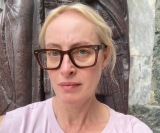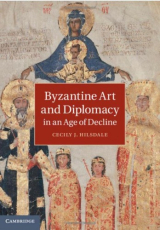 Associate Professor, Art History Program
Associate Professor, Art History Program
Advisor and Program Director of the Interdisciplinary Minor in Medieval Studies (MDST)
Co-Director of the Research Group on “Global Pasts” at the Lin Center
Professor Hilsdale specializes in the arts of Byzantium and the wider Mediterranean world. Her research focuses on diplomacy and cultural exchange, in particular the circulation of Byzantine luxury items as diplomatic gifts as well as the related dissemination of eastern styles, techniques, iconographies and ideologies of imperium. Other academic interests include the intersection of ritual and representation, gender and patronage, image theory, as well as the art and architecture of medieval Spain.

Her book, Byzantine Art and Diplomacy in an Age of Decline (Cambridge University Press, 2014) questions how political decline re-figures the visual culture of empire by examining the imperial image and the gift in later Byzantium (13th-15th century). Providing a nuanced account of medieval artistic cultural exchange this study reassesses the temporal dimensions of power and the changing fates of empires. In addition to a book subvention from the Medieval Academy of America, it was awarded the 2015 Dionysius A. Agius book prize from the Society for the Medieval Mediterranean.
Professor Hilsdale’s research has received support from the Institute for Advanced Study in Princeton, the Social Sciences and Humanities Research Council of Canada, the National Endowment for the Humanities, the American Philosophical Society, the Dumbarton Oaks Center for Byzantine Studies, and the Fulbright Foundation.
Her current research considers the entangled historical trajectories and power dynamics embodied by precious objects—more specifically treasure. In situating late antique and medieval treasure at the intersection of power, loss, and historicity, this study provides a critical evaluation of how and why certain narratives become official cultural legacy or patrimony while others are marginalized. The project represents the continuation of her longstanding investments in the itineraries and networks created and elided by things over time in different hands and is supported by an Insight Grant from the Social Sciences and Humanities Research Council of Canada (“Treasure: Power, Loss, and Historicity in the Medieval Mediterranean and Beyond,” 2022-2026).
Publications
“Ritual and Authority in Hagia Sophia.” In The Cambridge Guide to the Architecture of Christianity, Volume I: Early Christian and Byzantine Architecture, 121-28. Edited by Ann Marie Yasin (General Editor Richard A. Etlin). Cambridge: Cambridge University Press, 2022.
“Materials of Devotion: Reassessing the Textile Gift in Byzantium.” In Textile Gifts in the Middle Ages: Objects, Actors, and Representations, 57-81. Edited by Christiane Elster, Stephanie Luther, Tanja Michalsky, and Stefanie Seeberg. Quaderni della Bibliotheca Hertziana 8. Rome: Campisanto Editore, 2022.
“Imperial Monumentalism, Ceremony and Forms of Pageantry: The Inter-Imperial Obelisk in Istanbul,” in The Oxford World History of Empire, Volume I: The Imperial Experience, ed. Peter Fibiger Bang, C.A. Bayly, and Walter Scheidel (New York: Oxford University Press, 2021), 223-265.
“The Culture of Decline in Later Byzantium,” in Coping with Geopolitical Decline: the United States in European perspective, ed. Frédéric Mérand (Montreal; Kingston; London; Chicago: McGill-Queen’s University Press, 2020), 53-76.
“Letters and Letter Exchange in Byzantine Art,” in A Companion to Byzantine Epistolography, ed. Alexander Riehle (Leiden and Boston: Brill, 2020), 374-402.
“The Timeliness of Timelessness: Reconsidering Decline in the Palaiologan Period,” in Reconsidering the Concept of Decline and the Arts of the Palaiologan Era, ed. Andrea Mattiello and Maria Alessia Rossi (London and New York: Routledge, 2019), 53-70.
“Worldliness in Byzantium and Beyond: Reassessing the Visual Networks of the Greek Barlaam and Ioasaph,” The Medieval Globe 3, no. 2 (2017): 57-96. This special issue of the journal, edited by Christina Normore, is dedicated to A World within Worlds? Re-Assessing the Global Turn in Medieval Art History.
“Translatio and Objecthood: The Cultural Agendas of Two Greek Manuscripts at Saint-Denis,” Gesta 56, no. 2 (Fall 2017): 151-78.
“The Thalassal Optic,” in Can We Talk Mediterranean? Conversations on an Emerging Field in Medieval and Early Modern Studies, ed. Brian Catlos and Sharon Kinoshita (Palgrave Macmillan, 2017), 19-33.
“Visual Cultures of the Medieval Mediterranean,” in Peregrine Horden and Sharon Kinoshita, eds., A Companion to Mediterranean History (John Wiley & Sons, 2014), 296-313
“Gift,” Studies in Iconography 33 (2012): 171-82. This special issue of the journal, edited by Nina Rowe, is dedicated to Medieval Art History Today: Critical Terms.
“The Imperial Image at the End of Exile: The Byzantine Embroidered Silk in Genoa and the Treaty of Nymphaion (1261),” Dumbarton Oaks Papers 64 (2010): 151-99.

“The Social Life of the Byzantine Gift: The Royal Crown of Hungary Re-Invented,”Art History 31/5 (November 2008): 602-31.
“Constructing a Byzantine Augusta: A Greek Book for a French Bride,” Art Bulletin 87/3 (September 2005): 458-83.
“Towards a Social History of Art: Defining ‘Mozarabic,’” Medieval Encounters: Jewish, Christian and Muslim Culture in Confluence and Dialogue 5/3 (1999): 272-89.
Recent Podcasts
“Why is There an Egyptian Obelisk in the Hippodrome of Constantinople?” episode 49 of Byzantium & Friends hosted by Anthony Kaldellis, May 6, 2021.
“Byzantine Soft Power in an Age of Decline” episode 18 of Byzantium & Friends podcast hosted by Anthony Kaldellis, February 27, 2020.
Course Offerings
 In addition to undergraduate surveys of ancient and medieval art and architecture, Professor Hilsdale offers more specialized courses on such topics as Art and Crusade, the Arts of Medieval Spain, The Medieval City: Constantinople, and Medieval Pilgrimage: Creating Sacred Landscapes. Recent graduate seminars include:
In addition to undergraduate surveys of ancient and medieval art and architecture, Professor Hilsdale offers more specialized courses on such topics as Art and Crusade, the Arts of Medieval Spain, The Medieval City: Constantinople, and Medieval Pilgrimage: Creating Sacred Landscapes. Recent graduate seminars include:
- The Medieval Gift: Anthropological Theory and Art Historical Practice
- Medieval Materiality
- Medieval Encounters with Islam
- Objects as Frontiers: The Mediterranean Challenge to Medieval Art History
- The Pre-Modern Thing: Matter and Entanglement
- Threaded Worlds: Medieval Textiles and Modern Collections